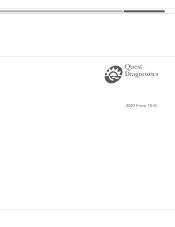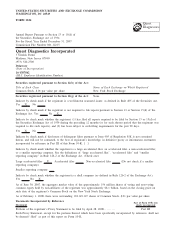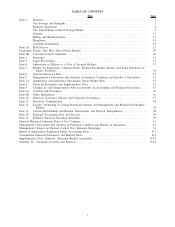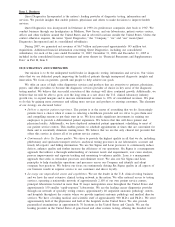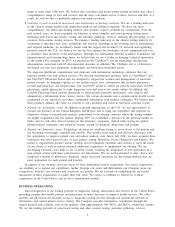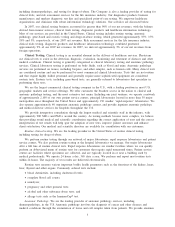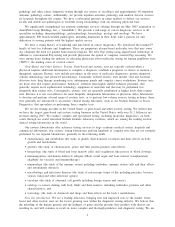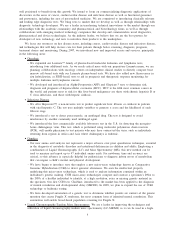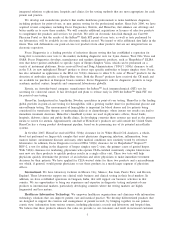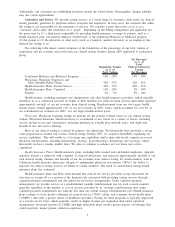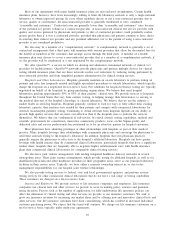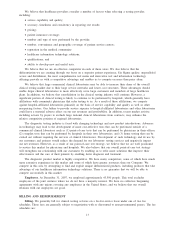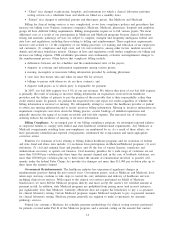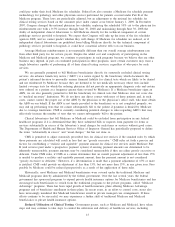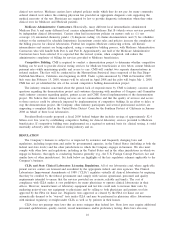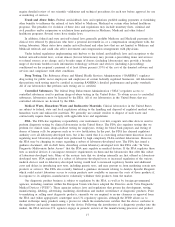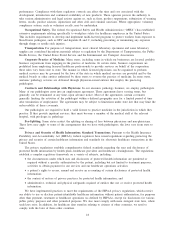Quest Diagnostics 2007 Annual Report Download - page 17
Download and view the complete annual report
Please find page 17 of the 2007 Quest Diagnostics annual report below. You can navigate through the pages in the report by either clicking on the pages listed below, or by using the keyword search tool below to find specific information within the annual report.loyalty by providing more convenient ordering and reporting of clinical tests and better access to patient-centric
information.
We develop and integrate clinical connectivity and data management solutions for healthcare organizations,
physicians and clinicians primarily through our Care360 suite of products and the ChartMaxx威electronic
document management system for hospitals. The Care360 products, including our Care360 Physician Portal,
enable physicians to order diagnostic tests and review test results from Quest Diagnostics online. In addition, the
Care360 Physician Portal enables physicians to electronically prescribe medication, view clinical and
administrative information in a patient-centric record maintained in our repository and share confidential
information with medical colleagues in a HIPAA-compliant manner. Demand has been growing for our
information technology solutions as physicians have expanded their usage of the Internet. By the end of 2007,
approximately 125,000 physicians were using our Care360 products and, excluding our recently acquired
AmeriPath business, approximately 65% of our test orders and approximately 75% of our test results were being
transmitted electonically. In December 2007, approximately 140,000 e-prescribing scripts were processed through
Care360.
Additionally, we have recently acquired the capabilities to deploy a health information exchange system
comprised of proprietary technologies that enable healthcare providers to access and manage a range of patient
data from multiple sources at the point-of-care. These capabilities will enable us to provide solutions to the many
health information exchanges that are being developed.
THE UNITED STATES CLINICAL TESTING MARKET
Most clinical tests are performed by one of three types of laboratories: commercial clinical laboratories;
hospital-affiliated laboratories; and physician-office laboratories. We believe that hospital-affiliated laboratories
account for approximately 60% of the market, commercial clinical laboratories approximately one-third and
physician-office laboratories the balance.
Key Trends. There are a number of key trends that we expect to have a significant impact on the clinical
testing business in the U.S. and on our business. These trends present both opportunities and risks. We believe
that the industry will continue to grow over the long term and that we are well positioned to benefit from the
long-term growth expected in the industry.
Demographics. The growing and aging population is increasing the demand for clinical testing.
Increased testing. We believe that we are entering the decade of diagnostics, moving to preventative care
from curative care. Physicians increasingly are relying on testing to aid in the identification of risk factors and
symptoms of disease, the choice of therapeutic regimen and the evaluation of treatment results. Physicians,
consumers and payers increasingly recognize the value of testing as a means to improve health and reduce the
overall cost of healthcare through early detection and prevention.
Science and technology advances. Medical advancements allow for more accurate and earlier diagnosis and
treatment of diseases. Continuing research and development in the area of genomics is expected to yield new,
more sophisticated and specialized diagnostic tests.
Health information technologies. Demand is growing toward comprehensive care management solutions that
serve patients, payers and practitioners by improving access to patient data, increasing patient participation in care
management, reducing medical errors and improving clinical outcomes. There is an increasing focus on
interconnectivity and desire for real time data aggregation. Electronic medical records and patient health records
continue to grow.
Customer consolidation. Our customers, including health insurance plans, employers, pharmaceutical
companies and other intermediaries, have been consolidating. We expect that this trend will continue.
Consolidation is increasing customer bargaining power and enhancing their purchasing sophistication.
Highly competitive. The clinical testing industry remains fragmented, is highly competitive and is subject to
new competition. Competition is growing from non-traditional competitors. New market entrants with extensive
resources may make acquisitions or expand into our traditional areas of operations. We also are expanding into
new diagnostic testing areas that are highly competitive.
Regulatory and policy environment. Government oversight of and attention to the healthcare industry in the
United States is significant and may increase.
Globalization. There is a growing demand for healthcare services in emerging market countries.
Opportunities are arising to participate in the restructuring or growth of the healthcare systems in these countries.
8


